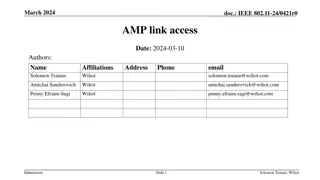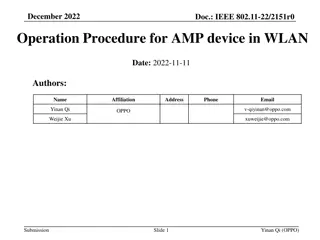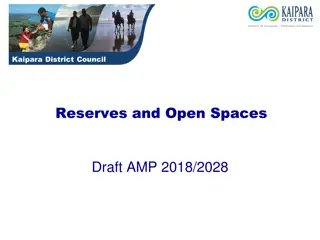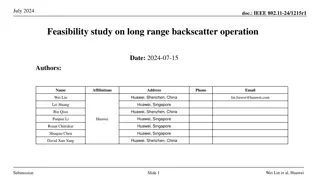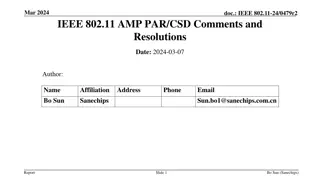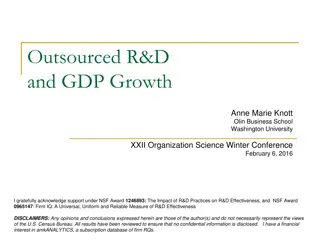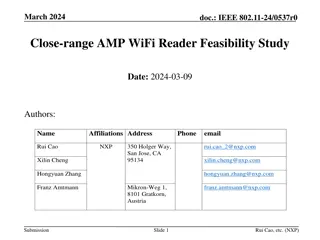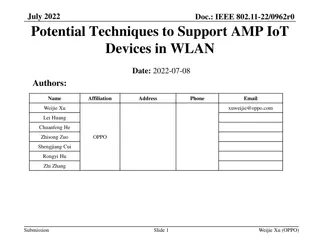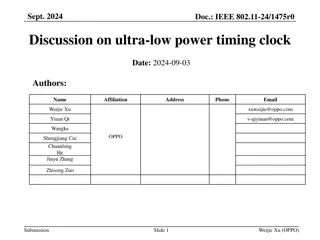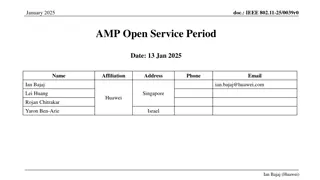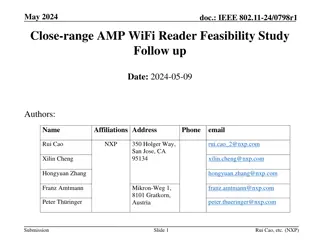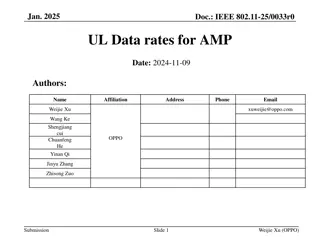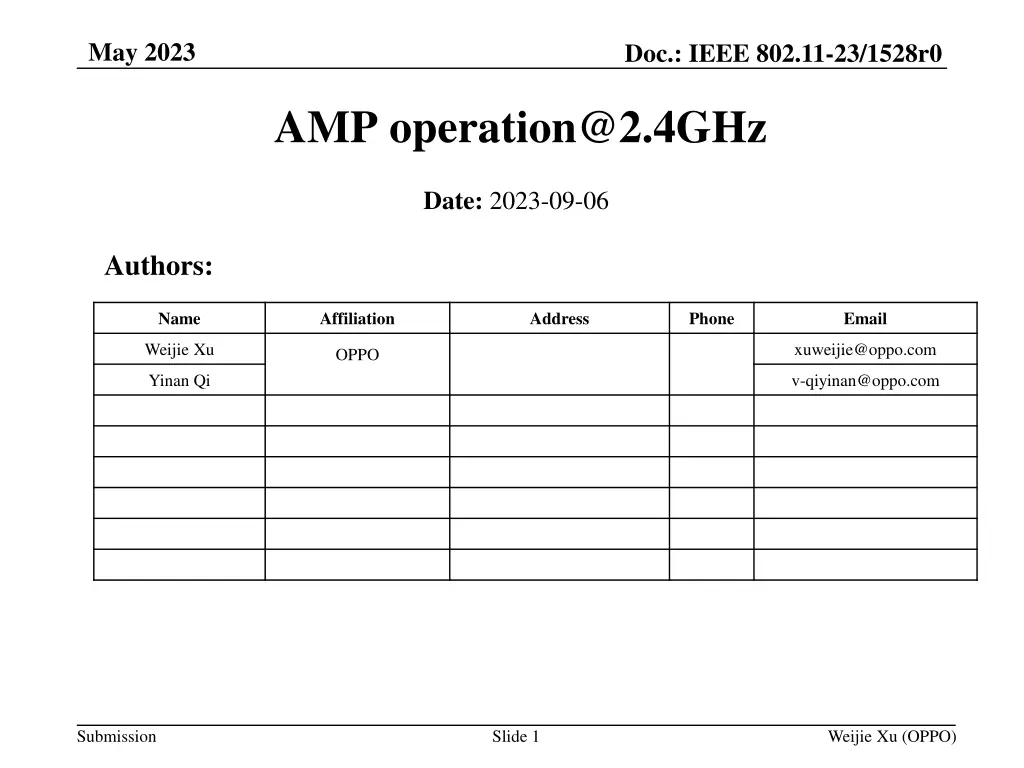
AMP Operation at 2.4GHz - Advantages and Traffic Characteristics
Explore the benefits and traffic characteristics of AMP operation at 2.4GHz in IEEE 802.11-23/1528r0. Understand the advantages, operation modes, and potential applications of this technology for efficient communication. Discover how AMP facilitates low-power, low-complexity communication with unique traffic patterns.
Download Presentation

Please find below an Image/Link to download the presentation.
The content on the website is provided AS IS for your information and personal use only. It may not be sold, licensed, or shared on other websites without obtaining consent from the author. If you encounter any issues during the download, it is possible that the publisher has removed the file from their server.
You are allowed to download the files provided on this website for personal or commercial use, subject to the condition that they are used lawfully. All files are the property of their respective owners.
The content on the website is provided AS IS for your information and personal use only. It may not be sold, licensed, or shared on other websites without obtaining consent from the author.
E N D
Presentation Transcript
May 2023 Doc.: IEEE 802.11-23/1528r0 AMP operation@2.4GHz Date: 2023-09-06 Authors: Name Affiliation Address Phone Email Weijie Xu xuweijie@oppo.com OPPO Yinan Qi v-qiyinan@oppo.com Submission Slide 1 Weijie Xu (OPPO)
Doc.: IEEE 802.11-23/1528r0 May 2023 Abstract In previous meetings, AMP operation @2.4GHz has been discussed. In this submission, we further discuss AMP operation @2.4GHz, including the operation mode, advantage of AMP operation@2.4GHz, traffic characteristics, coexistence with legacy WiFi devices, etc. Submission Slide 2 Weijie Xu (OPPO)
May 2023 Doc.: IEEE 802.11-23/1528r0 Operation modes @2.4GHz Two modes of operation@2.4GHz have been discussed. Mode 1: To support AMP STA with ultra-low power and ultra-low complexity. Both DL and UL communication in 2.4GHz: e.g. WUR(DL)+DSSS(UL)[3] DL air-interface: e.g. Reuse WUR design as much as possible UL air-interface: e.g. DSSS for backward compatibility - e.g. DPBSK, 1M kbps RF power transfer in other frequency band (e.g. Sub-1 GHz), or Energy harvesting can be up to implementation (if other ambient power is used) Mode 2: AMP STA compatible to existing WiFi network[4] The AMP STA is able to communicate with the AP with existing technology e.g. 802.11b/n. - AMP client STA can use a power optimized transceiver and operates in low duty cycle to communicate with existing AP. - Adding DL wake-up receiver (similar to 11ba) can further reduce the power consumption and reduce the DL response latency. Submission Slide 3 Weijie Xu (OPPO)
May 2023 Doc.: IEEE 802.11-23/1528r0 Advantage of AMP operation@2.4GHz A unified frequency band all over the world is beneficial to reduce the cost of AMP device via leveraging of market scale effect. It is also beneficial to support AMP application that may need to operate across different countries and regions. e.g. international logistics, supply chain management, personal belongings tracking etc. For both Mode 1 and Mode 2, it is possible to reuse the hardware of the existing AP since no new PHY waveform is introduced. In addition, it is possible to support AMP service by leveraging usage of the existing WiFi infrastructures in Mode 2. Submission Slide 4 Weijie Xu (OPPO)
May 2023 Doc.: IEEE 802.11-23/1528r0 Traffic characteristics As summarized in [1][2][3], AMP communication has the following traffic characteristics: Very small payload, generally the ID or sensor data, typically ranges from 96~256bits Extremely low duty cycle for most of the typical use cases - The traffic interval typically ranges from tens of minutes (e.g.15min) to several hours or even days High frequency traffic (e.g. in some use cases such as logistics) is normally isolated and constrained within a specific region, e.g., factory, warehouse, etc., and AMP traffic will be the dominant service traffic in the isolated area. Extremely low channel occupation as analysed in [5]: overall channel occupancy percentage is less than 0.5%. Submission Slide 5 Weijie Xu (OPPO)
May 2023 Doc.: IEEE 802.11-23/1528r0 Coexistence Analysis(1) It only reuses the existing waveform for both Mode 1 and Mode 2 and no new waveform is introduced. e.g.. for Mode 1, MC-OOK (in WUR) for DL and DSSS for uplink. e.g. for Mode 2, no issue for coexistence. In 2.4GHz, the AMP STA can easily co-exist with legacy WiFi devices In both Mode 1 and Mode 2, AMP STA is able to generate and transmit legacy WiFi preamble, i.e. DBPSK preamble or OFDM preamble. In Mode 1, similar PPDU structure as WUR can be reused in DL for coexistence with legacy WiFi devices. - Legacy Preamble followed by AMP data portion. Submission Slide 6 Weijie Xu (OPPO)
May 2023 Doc.: IEEE 802.11-23/1528r0 Coexistence Analysis(2) Comparing with other technologies, 802.11 AMP technology can be better coexistence with existing .11 devices It is an obvious trend to develop AMP technology in different standard organizations. Some Ambient IoT tehcnologies@2.4GHz have already been developed to fulfill the urgent market need. Developing AMP technologies with 802.11 that can well coexisted with existing 802.11 devices greatly benefit the whole 802.11 ecosystem AMP AP can provide protection for AMP client transmission and coexists well with existing .11 devices e.g. legacy preamble, TXOP sharing with client, etc Can flexibly schedule the AMP traffic based on the channel condition in a controllable manner Submission Slide 7 Weijie Xu (OPPO)
May 2023 Doc.: IEEE 802.11-23/1528r0 Coexistence Analysis(3) AMP client has a much smaller interference footprint comparing to typical 802.11 and other technology device operated in 2.4GHz band Transmission time and power is highly constrained by harvested energy. - The harvested power from wireless power transfer is likely in the order of several uWs or tens of uW - Even at the very low transmission power of -25dBm, the active Tx consumes power in the order of several mW - Due to the energy limitation, AMP client has to operate at very low duty cycle (<1%) - Low transmission power also limit the effective interference range Leverage waveform from existing technology like MC-OOK, DSSS, etc. Submission Slide 8 Weijie Xu (OPPO)
May 2023 Doc.: IEEE 802.11-23/1528r0 Summary In this submission, AMP operation@2.4GHz is discussed. We have the following observations and conclusions: There are obvious advantages of support AMP operation@2.4GHz. It will significantly benefit AMP applications and the whole WiFi ecosystem. The AMP device can maintain well coexistence with other WiFi devices The channel occupancy ratio by AMP devices will be very small due to the characteristics of AMP traffics and all AMP operation will be well controlled by the WiFi network thus the impact to other WiFi system is negligible. Therefore, we propose to support AMP operation@2.4GHz. Submission Slide 9 Weijie Xu (OPPO)
May 2023 Doc.: IEEE 802.11-23/1528r0 Reference 1. IEEE 802.11-23/0436r0, Technical Report on support of AMP IoT devices in WLAN 2. IEEE 802.11-22/1960r6, Summary and recommendation for AMP IoT 3. IEEE 802.11-23/0837r0, Further Discussion on AMP PAR 4. IEEE 802.11-23/1195r0, Thoughts on AMP IOT and PAR 5. IEEE 802.11-23/1354r0, AMP Device Channel Occupancy Analysis 6. IEEE 802.11-23/0835r1 "Use Cases and Requirements" Submission Slide 10 Weijie Xu (OPPO)




